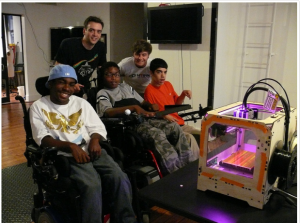
DIYAbility.org co-founder John Schimmel (rear, left) with workshop participants, including Matthew Altan (front row, far right). Read more about what Matthew’s been up to, below.
DIYAbility.org and digital fab are making a big difference in kids’ lives. They’re having fun, using technology, and are becoming empowered for productive & happy lives.
Where: New York City
Website: DIYAbility.org
Digital Fabrication Tools: ShopBot Buddy, MakerBot Replicator
This Fall at the 2013 New York City Maker Faire, John Schimmel and Holly Cohen of DIYability.org gave a presentation: The Accessible Maker Space: Makers with Mixed Abilities. It was a perfect setting to spread the word about the work of DIYability, whose tag line is:
Empowering people with & without disabilities to make their world…or… “Where MacGyver meets assistive technology!”
DIYAbility was started by John Schimmel and Holly Cohen (OT/ATP). John is a technologist and tinkerer who teaches Developing Assistive Technology and Web Development courses at NYU’s Interactive Telecommunications Program. Holly is an occupational therapist and assistive technology practitioner and teaches Rehabilitation courses at NYU Steinhardt’s Department of Occupational Therapy. Both have been involved with assistive technology design and implementation for several years and want to encourage more people to think creatively about technology and disabilities.
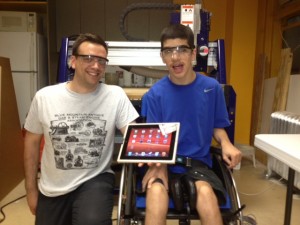
Left, DIYAbility’s co-founder John Schimmel, with Matthew Altan. They are showing off the finished iPad holder that Matthew designed and built.
John says, “Computers are great equalizers, empowering everyone to DO so much more in so many realms. Computer-controlled tools like the ShopBot allow for turning ideas into physical products regardless of physical abilities. Today if you can work a PC you can literally make anything. We’re bringing technology and making into the lives of children with disabilities… so they can discover their Abilities!!”
Holly noted that DIYAbility is approved by the American Occupational Therapy Association as a provider of Continuing Education. “We’re developing customized programs for occupational therapists (OTs) to incorporate digital fabrication into their work. Some of our goals for the future are to introduce tools like MakerBots and Shopbot Handibots into hospital OT programs. We’re also working on making kits available to OTs around the country.”
John adds, “We share space with Adaptive Design (adaptivedesign.org), a Manhattan-based organization that designs and builds child-specific, adaptive equipment and trains others to do the same. We also collaborate with them. For example we’ve helped Adaptive Design use the ShopBot Buddy to cut cards for their Tangible object cues for deaf and blind students.”
One young person who benefits from working with DIYAbility is Matthew Altan, a 16-year old from Queens, NY. In a recent interview Matthew’s mom Elda spoke about Matthew. “His disability is cerebral palsy; his use of his limbs are compromised, and he is non-verbal. BUT… technology is giving him freedom and expression.”
Matthew is absolutely passionate about technology… and using technology allows Matthew to be active and productive. Elda notes, “In the past, cerebral palsy meant you stayed at home and you basically did nothing.” As Matthew expresses it, “I love technology because it’s fun to figure out. I love to learn how things operate and I also like inputting code to hack into things!”
Matthew is able to speak and communicate via email with the help of Verbally, a free iPad app. Elda says, “Matthew’s a total computer ‘nerd’ who carries a laptop and iPad everywhere he goes.” He dreams of being an automation engineer — and is on the path to achieving this dream. This summer, he and his parents came to DIYAbility’s Making the Future – Digital Fabrication Event (made possible by Cognizant’s Making the Future initiative; www.facebook.com/MakingTheFuture)
Matthew uses his left index finger to run a computer trackpad or keypad. At a workshop this past summer, John helped Matthew to be able to design and make a simple iPad holder of balsa wood on the Shopbot. Matthew was able to use Vectric to design the holder with correct dimensions and then control the CNC by loading the toolpath file and zeroing the machine.
Matthew wrote of this experience, “We had a lot of fun but I have to tell you that it was a kind of learning experience for me and John because we had to have a stronger bit… You have to know that with the ShopBot you have to pick the right router bit.”
“We were a perfect team,” says John. “Matthew uses the trackpad to use Vectric, and the keypad to control the ShopBot. I laid down the materials, Matthew ran the software!”
In Elda’s words, “Matthew loves the DIYability.org workshops. He likes being around other kids, those that are his age and many who are older who are comfortable around him and just want to learn and work together. The older kids want to work with him, be a mentor….. so it’s a two-way street.”
Elda says, “My goal is to prepare him for an independent, happy life as an adult, doing what he loves.”
Asked if he has a picture in mind of the type of career he’d like to pursue one day, Matthew wrote, “I would be collaborating with 3 corporations such as Microsoft and Google and Nike on designing and selling new products. My actual designs are going to be both on a computer and also on paper. And I would also like to work for GE and work with them to develop unique products for home automation for the general population, and physically and mentally disabled people.”
Another great initiative of DIYAbility is their Hack for the Holidays workshops, where occupational therapists, parents and children get together to learn how to modify off-the-shelf toys for switch access. What is “Switch Accessibility,” you ask? For many kids with physical disabilities playing with off-the-shelf toys is not possible; depending on their unique abilities a toy might not be accessible. However, if a child can move their head, feet, arm, mouth or any other part of their body it is possible to use a switch to play with the toy. At DIYAbility’s Hack for the Holidays workshops, people learn how to easily modify toys for accessibility. At a recent Hack event, John noted, “We modified remote control trucks, coin banks, bubble blowers and more. We had a 100% toy hack success… having more fun voiding warranties and making the holidays more accessible!”
John sums it up, “We believe that people with and without disabilities can be empowered when using the correct technology. More importantly, we want everyone to know they have the right to participate in the design & making of technology – having the opportunity to make your own ‘stuff’ can lead to increased quality of life, maintaining independence, perhaps a new career and staying curious about the world. Making also happens to be really fun!”
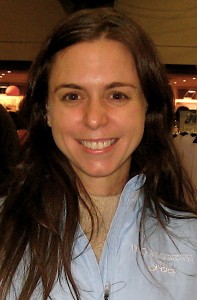
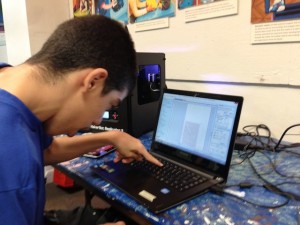
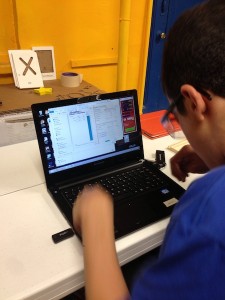
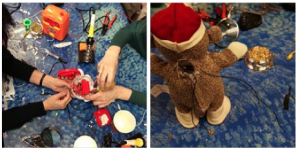
Leave a Reply